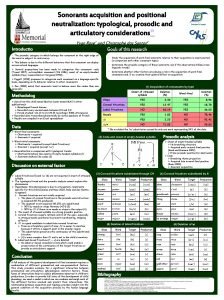Sonorants acquisition and positional neutralization typological prosodic and

- Slides: 1

Sonorants acquisition and positional neutralization: typological, prosodic and articulatory considerations* 1 2 Yvan Rose and Christophe dos Santos Introductio Goals of this research * This research is financed by the National Institute of Mental Health Grant #IR 0 IMH 60922 -01 A 2, project author K. Demuth (Brown University, Providence). n Ø The prosodic category to which belongs the consonant at the right edge of 1 Department of Linguistics, Memorial University, Canada; 2 Laboratoire Dynamique Du Langage (UMR CNRS 5596) Université Lumière Lyon 2, France • Study the acquisition of word-final sonorants relative to their acquisition in onset position (in comparison with other consonant types) the word is subject to controversy Ø This debate is due to the different behaviors that this consonant can display across natural languages • Determine the prosodic category of these sonorants; see if the observations follow crosslinguistic trends Ø Several propositions has been made to categorize this consonant: coda (Tranel 1987), extrasyllabic consonant (Itô 1986), onset of an empty-headed syllable (Kaye, Lowenstamm et Vergnaud 1990)… • Determine whether other factors are playing a role in the acquisition of word-final consonants and, if so, examine their general effect on acquisition Ø Piggott (1999) proposes to categorize each consonant on a language-specific basis, depending on its behavior relative to other consonants Ø Zec (1988) noted that sonorants tend to behave more like codas than nonsonorants (1) Acquisition of consonants by type Onset of stressed syllable Methodolog yØ Data from the child named Marilyn (code-named MAS in other Deletion (%) Word-final Deletion (%) Stops YES 3, 30 YES 8, 96 publications): Ø Monolingual French learner Ø Recorded every second week between 0; 9 and 3; 0 Ø Period studied: 1; 11. 13 to 2; 2. 29 (8 recordings; 5386 utterances) Ø Recorded data transcribed phonetically by native speakers of French Ø Results are compiled in an Excel spreadsheet Coronal fricatives YES 12, 47 YES 18, 78 Labial Fricatives NO 60, 19 YES 36, 00 Nasals YES 1, 82 NO 78, 46 /l/ YES 2, 20 NO 92, 43 Data /ʁ/* NO 71, 83 NO 95, 80 Ø Word-final consonants: Ø Obstruents = acquired Ø Sonorants ≠ acquired * We excluded the /n/ substitution caused by only one word representing 54% of the data. Prosodic analysis (2) Coda and onset of empty-headed syllable Ø Word-initial consonants Ø Obstruents = acquired (except labial fricatives) Ø Sonorant = acquired (except /ʁ/) Ø Onset of empty-headed syllable Ø No branching structure Ø Acquired early in word-final position (Goad and Brannen 2003) Ø Prime prosodic position for obstruents Ø Coda Ø Branching rhyme projection Ø Acquired late in word-final position (Rose 2000) Ø Sonorant acquisition Ø Generalization in comparison with typological trends: Ø Obstruents behave like onsets of empty-headed syllables (2) Ø Sonorants behave like codas (2) Discussion on external factor Ø Labial fricatives (5) and /ʁ/ (6) are not acquired in onset of stressed syllable Ø The typological trend and the prosodic analysis cannot explain this phenomenon Ø Hypothesis: this phenomenon is due to articulatory constraints specific for this child (Inkelas and Rose 2003, Rose and dos Santos, to appear) 1. Coronal fricatives are not totally acquired Ø The place of coronal fricatives in the prosodic word structure is acquired (87, 5% produced) Ø The segment is not acquired: 80, 25% are substituted Ø 50% by nasals or stops Harmony (=CH) (3) Ø 50% by /l/ if there is no nasals or stops in the output (4) 2. The onset of stressed syllable is a strong prosodic position 3. Coronal fricatives require refined control of the apex, especially in strong prosodic positions (to prevent overshooting, stopping effects) 4. /l/ is a good candidate to substitute coronal fricatives Ø From an articulatory point of view, /l/ is easier to maintain because it offers a support point in the alveolar region Ø The substitution preserves the continuancy of the substituted fricative Ø [ɬ] is more complex than /l/ and is not in the child’s inventory 5. Labial and dorsal fricatives [f, v, ʁ] are deleted Ø No labial or dorsal consonant exists which could enable a preservation of the continuancy of the target fricatives or provide an articulatory support Conclusion A full analysis of the general development of final consonant requires a combination of different grammatical and non-grammatical factors. This study provides evidence for a significant interaction between grammatical and articulatory (physiological, motoric) factors. These types of interactions help to explain phenomena observed in children’s productions. In order to provide full story of the development of child phonology, we need a model in which we can combine and weigh each of the different factors involved and predict their interactions. The relationship between acquisition and typology provides insight into the general condition of the acquisition process by the human language faculty (3) Coronal fricatives substituted through CH Gloss Word Target Production (4) Coronal fricatives substituted by /l/ Gloss Word Target Production [ʃosyʁ] [lyly] [sɛ] [lɛ] [pɛ so ] [lo] thanks merci [mɛʁsi] [mɛːni] shoe chaussure to passer [pase] [pete] it's c'est damn! zut [zyt] [dyt] paintbrush pinceau house maison [mɛsɔ ] [mɛdɔː] thing chose [ʃoz] [los] scarf écharpe [eʃaʁp] [tap] cat chat [ʃa] [la] to cheat tricher [tʁiʃe] [te] eyes yeux [zjø] [lø] yellow jaune [ʒon] [no] house maison [mɛsɔ ] [lõ] major majeur [maʒœʁ] [mɛmɛ] to arranger [ʁɑ ʒe ] [leː] (5) Deletion of labial fricatives Gloss (6) Deletion of /ʁ/ Word Target Production strong fort [fɔʁ] [ɔ] stop fairy fée [fe] [e] soccer foot [fut] sheet feuille green Target Production arrête [aʁɛt] [ɛt] rinse rince [ʁɛ s] [aːs] [ut] rose [ʁoz] [os] [fœj] [œː] syrup sirop [siʁo] [o] vert [vɛʁ] [ɛː] dress robe [ʁob] [ɔpp] seen vu [vy] [y] rail [ʁaj] [aj] wave vague [vag] [ak] godfather parrain [paʁɛ ] [paaː] lavé [lave] [e] square carré [kaʁe] [kaeː] washed Gloss Word Bibliography Goad, Heather and Kathleen Brannen (2003). Phonetic Evidence for Phonological Structure in Syllabification. In The Phonological Spectrum, Vol. 2, Jeroen van de Weijer, Vincent van Heuven and Harry van der Hulst (eds. ). Amsterdam: John Benjamins. 3 -30. Inkelas, S. , & Rose, Y. (2003). Velar Fronting Revisited. Paper presented at the Proceedings of the 26 th Annual Boston University Conference on Language Development, Somerville, MA. Itô, J. (1986). Syllable Theory in Prosodic Phonology. Unpublished Ph. D. Dissertation, University of Massachusetts, Amherst. Kaye, J. , Lowenstamm, J. , & Vergnaud, J. -R. (1990). Constituent Structure and Government Phonology, 7, 193 -231. Piggott, G. L. (1999). At the Right Edge of Words. The Linguistic Review, 16(2), 143 -185. Rose, Y. (2000). Headedness and Prosodic Licensing in the L 1 Acquisition of Phonology. Unpublished Ph. D. Dissertation, Mc. Gill University. Rose, Y. , & dos Santos, C. (à paraître). Influences multiples dans l'harmonie consonantique et la métathèse en acquisition du français. Recherches linguistiques de Vincennes. Tranel, B. (1987). The Sounds of French : An Introduction. Cambridge, UK: Cambridge University Press. Zec, D. (1988). Sonority Constraints on Prosodic Structure. Unpublished Ph. D. Dissertation, Stanford University.

